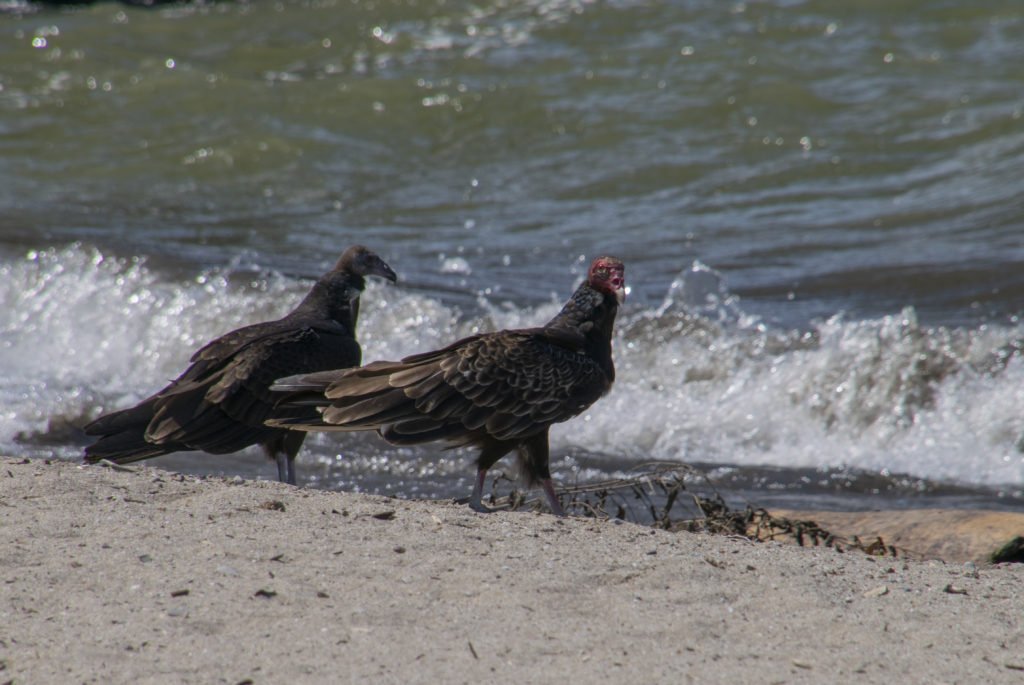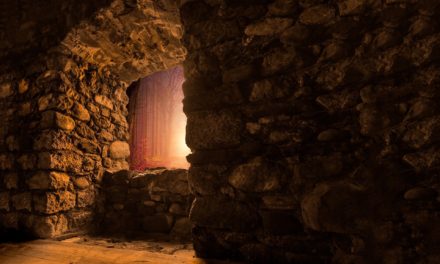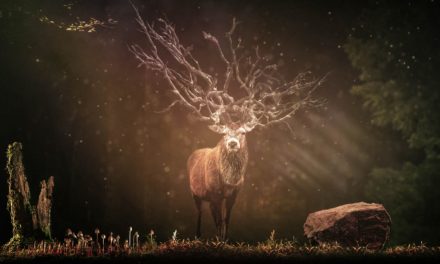I was secluded in residency in the mountains of Amherst, Virginia, at the Virginia Center for Creative Arts. In the couple of weeks before I left home, I’d written two new poems about vultures, with ideas in my head for two more. I’d been writing poetry based in the anatomy of birds for some time, gradually coming to trust the sight and sound of them, to listen more quietly to my surroundings, to be mindful of whatever decided to show itself to me. Eventually, my work shifted into a new focus on sacred bird mythologies and, more and more, it was the vultures that continued to appear.
Six months or so before my residency, where I’d hoped to work on an essay related to personal trauma, a small wake fed in the middle of the street while I was driving through our suburban Ohio neighborhood. I was in enough of a hurry that, even in my astonishment at seeing them there, I wasn’t able to stop. I slowed down enough to maneuver around them, the five or six enormous birds circled around something in the road I couldn’t see. I expected them to rise up flapping, disturbed by my car as I approached, but they were wholly unperturbed. Except for one. He watched me carefully at almost eye level, his head swiveling slowly as I drove past him. It seems overly romantic to say that his eyes met mine, that our gazes held on to one another, but that is, in fact, what it felt like. Where I was headed that I felt I couldn’t stop I cannot now remember, but I do know I was distinctly aware this meant something.

Soon after, an extended family of vultures settled into the back yard of a close acquaintance, a poet from Delaware, Ohio. I only heard of this happening late in the summer, with too many other things going on to arrange a visit to see, but he was much frustrated, claiming the ninety or so birds that arrived in the spring had thinned themselves down to sixty, still a huge number to have taken up residence in a grove of trees at the far end of his yard. He described it a miserable experience to have one swoop down close to his head, and he lamented the green of his lawn giving way to what he and his wife decided to call “summer snow.”
I kept reading about vultures, I kept writing about them, I took one of the completed poems with me to a feature I was doing in Athens, Ohio, just a few days before leaving for Virginia. As I drove down the narrow road to the venue following my daughter and son-in-law who were driving a separate car, a black cloud of wings swept over the top of their windshield. I was sure it must have frightened my daughter badly. When I asked about it later, they didn’t know what I was talking about; they hadn’t seen anything at all. On the road, when the wings had dusted the top of their car, I slowed almost to stopping to peer into the woods where they’d disappeared. A pair of vultures were standing calmly on the ground together, peering back at me.
More vultures met me in Amherst on the second day after I arrived, circling in pairs over the mountain-top barn and fields. I decided there and then, with no other distractions to blame, I would stop what I was doing entirely and follow them. They led me out past the barn and down the road behind our studios but then flew so far away I could no longer see them. Determined, I sat on the bridge that crossed over the train tracks, waiting for them to come back. I leaned my head back, closed my eyes, and allowed myself a few moments to soak in the afternoon sun. When I looked up, another poet in residence was headed my way, head cocked slightly to one side, and I realized he must be concerned. I smiled and waved so he could see I was okay. I told him I was waiting for the vultures to return.
It’s the kind of thing one poet can say to another at a place like that. He just nodded and sat down beside me. We talked a while before deciding to head back to the studios together, and as we entered the dirt road that led back to the barn, a pulsing black-winged mass swooped low over the road in front of us. “They’re back!” I whispered.
“Who?” he said. “What?”
“The vultures!” I hissed, genuinely shocked he’d not seen what happened just thirty or so feet away. But when the same bird swooped down low again, he did, and this time his jaw dropped open. We lowered our voices to a whisper.
“Well, look at that!” he said. “Wait, what do you think they’re doing?”
There were two of them now, one of the two pairs that had been circling all day. They rose a little and fell again, as if trying to decide where to land, moving to the far edge of the field at our left where we could see their features more clearly: their bald red heads; their ivory beaks; their feathered bodies now so clearly a rich, dark, brown as they stood there in the afternoon light, not the jet-black they’d appeared to be while swooping. “Is it…could it be mating season? I mean, what are they going to do?”
“I have no idea,” I said, “but I’m going over there to sit and watch.” I pointed to the shade of a tree with low-hanging branches, a perfect spot to both hide and observe, and was already pulling off my jacket to spread on the ground. “You can go if you want to,” I whispered. “I want to stay.”
He touched my shoulder lightly. “This is a good omen for you,” he said. I was grateful for that. He lifted his chin and smiled, nodding his goodbye, then made his way up the path while I sat down alone with the birds.

My whole first week was like that: wildlife of all kinds announcing themselves and retreating, a new creature each day calling out its presence, telling me, “I’m here.” The first thing I’d put in my suitcase while packing to come was my animal medicine cards. Medicine Cards: The Discovery of Power Through the Ways of the Animals by Jamie Sams and David Carson is a lovely boxed set of beautifully illustrated cards with accompanying text. I’ve had them for thirty years; they were given to me by my oldest sister around the time I was newly married. I used them the first day here, after laying out a spread that included Bear, Ant, Rabbit, Crow, and Spider. I pulled the Hawk card, too, placing it above the others. It was not a random spread; I pulled all the animals that made their presence known to me during my first day here. I started with Bear not because I’d actually seen him, but because in the week before I’d come, an acquaintance who lives in Amherst had been tagged on Facebook to be careful with his dogs, as bears had been seen in the area. Every closet fear I had about coming—knowing what I wanted to write about, that I’d be trying to find the source of this mysterious trauma—fed itself into a fear of encountering a bear somewhere on these grounds. When I felt brave enough to ask one of the residents if indeed there were bear here, she smiled and said not that she knew of, no bears, but it would make a wonderful story; perhaps we could start a rumor that there was.
It had occurred to me when I put the cards in my suitcase that perhaps this fear of bears was out of proportion, or rather, that I needed to look at this Bear energy differently. Bear’s picture is right on the cover of the boxed set, after all, and I knew Bear was keeper of the Dream Lodge. Maybe Bear’s imposing presence that week had been an insistence that I see him as guide. Now that I was there and given a chance to laugh about it, I was sure that was the case. Bear connects to “female receptive energy” and retreats in hibernation to “digest the year’s experiences.” This was, indeed, a good and now friendly place to start my meditation.
I’d arrived after dark on a Monday, unloaded my suitcases at the residence, and drove to the studios down at the barn where a large spider skittered away from the door as I approached it. So I pulled Spider, the weaver of words. The first truly wild animal I saw was at breakfast, a small rabbit outside the dining room window. I pulled Rabbit, who tells us our fears are largely unfounded. On the walk back down to the studio after breakfast, crows cawed loudly from the trees; shape-shifter was no surprise to me as I pull that card so often. And when I encountered a small army of ants in the barn’s kitchen, then even more of them at my desk when I sat down to work in earnest, I realized I had to pull Ant. Ant’s medicine is patience. Finally, I pulled out Hawk, Messenger, who’d been soaring all morning and afternoon, wings spread wide and banking into the sunlight so I saw his back glow a beautiful auburn-gold. Hawk, too, is a card I draw often, whose medicine is with me all the time, so though I already had the five cards needed for my Moon Lodge Spread, I placed him above it in the same way he’d soared above me earlier. “The test is your ability to observe the nuances of power lurking nearby,” the authors explain about Hawk. “You are only as powerful as your capacity to perceive, receive, and use your abilities.”
I actually never saw any vultures my first day there; they’d be back later. These were the animals who had so far been willing to show themselves, whom I needed to get myself centered. I pinned them on the bulletin board over my desk so that when I started typing that first sentence, “It’s time to talk about the little girl, who she is, why she came to me,” I had an audience in front of me both listening and offering their assistance as I plodded my way through telling what happened and trying to understand why.
I sat on my coat under the tree watching that pair of vultures for perhaps five or ten minutes without being fully sure what was happening. One stood absolutely still, statuesque, his head turned to profile so I could see his wide-open eye. The other bird rose and danced, flapped his wings, as if he wasn’t able to settle. Then he rose higher, circling the field, then higher, lower, higher, until I understood how the sun was casting his shadow in the same haphazard pattern across the edge of the field and through the trees where the woods began. I understood, suddenly, that meant I could see the bird even when I did not see the bird. Call it a koan, but here it was played out before me, loud and clear, and as soon as I understood, he rose higher and flew completely away.

The other bird remained in the field in exactly the same, stolid pose, head in the exact same position: the red profile of this face, the single round eye watching. I began to realize he was standing at the highest point of this open, uneven, clearing. The hay had just been cut and still lay on the ground in long, pale, curving rows. He was telling me that that was where I needed to stand, too: on higher ground for clear perspective. It might have been a metaphor, but since my knees were starting to hurt anyway, I took it as invitation. I stood up, and the movement did not seem to frighten him. It made no sense to walk straight across the field toward him; the bird was bound to fly away, so I crossed over to the edge of the woods where I could sidle up the edge of the field and make my way more subtly toward him. Just as I approached the wood line, I heard a loud noise from inside the trees, something much bigger than a squirrel but without the accompanying swish made by the full body of a deer. Something had stepped on and snapped a very large twig or branch. I froze in place for a fraction of a second, calculating what I’d heard, whether something in the trees was headed toward me or away, whether I needed to be on guard. I could see in my peripheral vision that the bird had still not moved. This, too, I took as a sign. A snapped twig or broken tree limb may or may not be a deer—or a bear. It may or may not be a lot of things, but in this moment, it was causing me no danger.
I made my way toward the vulture noisily enough myself; it was not so easy to skulk along the treeline. The newly sheared ground was soft and uneven, covered in detritus alternately damp, dry, and tangled into mounded knots. I kept my eyes cast down, watching my footing carefully, and could see—again, from my peripheral vision—that he was moving. Rather than fearing I was scaring him off, I understood that he was making way for me to stand where he had been. I turned my head in enough time to see him lift off the ground and fly away.
I’d not realized from my shady spot under the tree just how close he was to the very back edge of the field, where a line of saplings and shrub served as border between this and the next hayfield. There was a break in the scrub large enough for a person or even a small tractor to get through it. I stood exactly where the vulture had been, on the highest little rise in the field, and recognized that this was a place of transition. I could see clearly across the grounds of the barn and studios straight through to my office, which juts out at the far east end. Beyond that, I already knew, were the woods that dropped off quickly to the train tracks, everything down there but the tracks themselves covered in kudzu. Immediately behind where I stood was that opening in the scrub line, tiny chirping birds and all kinds of insects skittering to and fro. The field it led into had a distinctly different curvature than the one I’d just come through and darker, richer-looking soil, but it was otherwise similar, striped with new-mown hay awaiting its harvest. The location was, I realized, itself a metaphor, a lesson about standing on the precipice between two places, a portal between two worlds.
~~~
There was no vulture in the set of animal medicine cards I’d brought with me, but nor did I feel I needed one. (Some time later, my husband gifted me with a new set of cards by Susie Green called Bird Messages, which does.) Those beautiful birds stayed with me every day I was there. I’d purposely scheduled the residency to include my birthday, and on that morning, I let myself sleep in, lingering lazy in my bed. When I rose and opened the curtains, a familiar black shadow swooped in front of the sliding-glass patio doors, an enormous vulture calling me down the path that led to the studio barn. “All right, all right,” I said. “I’m coming.” I dressed quickly and made my way down a curve in the path to see no less than twelve vultures settled on top of the barn and in the surrounding trees, a welcoming committee silently affirming the work I’d come there to do.

 All photographs by Rob Smith.
All photographs by Rob Smith.
Rob Smith grew up in NE Ohio, but his career took him to Pennsylvania, New Jersey, and southern Ohio. In 2005, he moved to Huron to finish his novels and write poetry. In 2006, he won the Robert Frost Poetry Award, and was Huron’s Poet Laureate from 2009-2011. Three of his works, The Immigrant’s House (poetry), McGowan’s Call, and Sand Dollar Island (novels) are catalogued in the Library of Congress. He and his wife, Nancy, share an enjoyment of photography, and have just completed the third edition of 44839: Poetry From a Zip Code, a collection of community poetry submitted for an annual contest they sponsor with the Huron Library and City of Huron. SmithWrite.net






